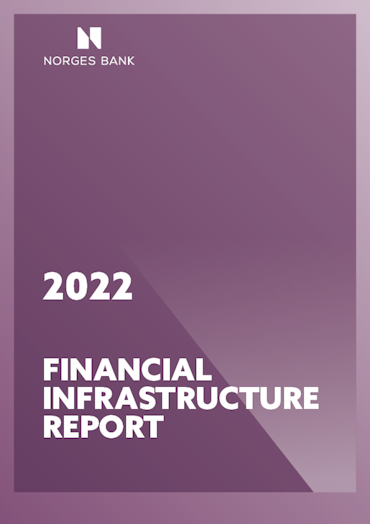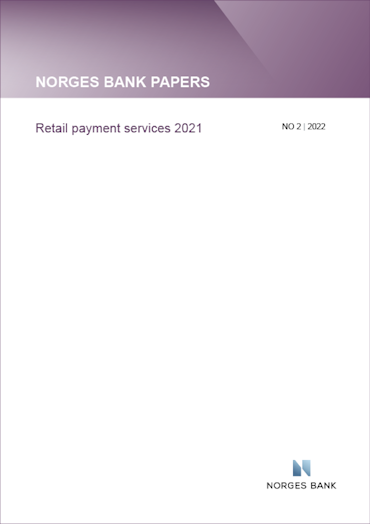Financial infrastructure 2022
Norges Bank discusses developments, vulnerabilities and risks in the financial infrastructure.
A well-functioning payment system continues to evolve
Norges Bank is today publishing Financial Infrastructure Report 2022 and Norges Bank Papers 2/2022, "Retail payment services 2021".
The Norwegian payment system features standardised and user-friendly solutions. A new survey by Norges Bank shows that payment costs are low compared with other countries. As a share of mainland GDP, resource use has decreased somewhat between 2013 and 2020.
Threats to fundamental national interests and critical infrastructure are increasingly cyber-related. Cyber attacks are used by various threat actors and may be a tool in wars and conflicts. Norges Bank and Finanstilsynet (Financial Supervisory Authority of Norway) are working together to introduce cyber resilience testing in accordance with the TIBER framework in Norway. Testing is expected to begin in 2023.
“Cyber incidents are a potential threat to the financial system and financial stability. Globally there is broad agreement that resilience against cyber attacks in the financial sector must be strengthened. This requires extensive public-private cooperation”, says Governor Ida Wolden Bache.
Norges Bank is assessing whether the public should have access to a central bank digital currency (CBDC). The Bank is now conducting experimental testing of technical solutions, while the purposes and consequences of introducing a CBDC are analysed further.
Crypto-assets are currently rarely used for ordinary payments, while other applications are experiencing strong growth. The development of stablecoins, digital currencies intended to have a stable value against official currencies, may help to give crypto-assets a greater role in ordinary domestic and cross-border payments.
“Crypto-assets and associated services need to be better regulated. Norges Bank is monitoring developments and will contribute to regulation that promotes responsible innovation”, says Governor Ida Wolden Bache.
Executive Board’s assessment
The Financial Infrastructure Report is part of Norges Bank’s work to promote financial stability and an efficient and secure payment system in Norway. The Executive Board discussed the content of the Report on 27 April 2021.
Norges Bank supervises and oversees key financial market infrastructures (FMIs), issues cash and ensures settlement of interbank payments. At the same time, Norges Bank promotes change that could make the payment system more secure and more efficient. An efficient payment system carries out payment transactions swiftly, at low cost and tailored to users’ needs.
The Executive Board considers the Norwegian financial infrastructure to be secure and efficient. The Norwegian payment system has long featured standardised and user-friendly solutions, and the social costs of payments appear to be low compared with other countries. The operation of the financial infrastructure has been consistently stable.
The payment landscape is evolving, with internationalisation, new providers and new payment methods making their mark. At the same time, cyber threats are growing. These structural changes are the reason that Norges Bank is assessing whether measures are needed to enable the public to pay efficiently and securely in NOK also in the future. Key issues are related to cyber resilience, the real-time payment infrastructure, central bank digital currency (CBDC) and cash.
Threats to fundamental national interests and critical infrastructure are increasingly cyber-related. Over the past two years, there has been an acceleration of digital risk in Norway, with a marked rise in the number of serious incidents. Cyber attacks are used by various threat actors and may be a tool in wars and conflicts.
Cyber incidents are a potential threat to the financial system and financial stability. Globally there is broad agreement that resilience against cyber attacks in the financial sector must be strengthened. This requires extensive public-private cooperation, which has been a defining feature of the Norwegian payment system. Norges Bank and Finanstilsynet (Financial Supervisory Authority of Norway) are working together to introduce cyber resilience testing in accordance with the TIBER framework in Norway (TIBER-NO) to bolster the cyber resilience of the financial system. Critical functions to be tested and the entities responsible for them have been identified. Testing is expected to begin in 2023. TIBER-NO testing includes the sharing of experience with testing and therefore also involves collaboration with private entities.
A well-functioning real-time payment solution is a key component of an efficient payment system. Real-time payments are payments where the funds are available in the payee’s account seconds after the payment is initiated. Norges Bank has entered into formal discussions with the European Central Bank (ECB) on possible participation in the Eurosystem’s TARGET Instant Payment Settlement (TIPS) service. The primary objective is to facilitate the development of new real-time payment services for customers. Norges Bank is in the process of reviewing and assessing the TIPS service at a detailed level, including the technical setup, security, contingency arrangements and costs. This work will lead to a basis for deciding on a possible participation in TIPS, which safeguards Norges Bank’s requirements and the needs of other relevant stakeholders.
The international messaging standard ISO 20222 will be the standard for payment messages in Norway. ISO 20222 enables messages to contain more information and the information is structured in a way that better facilitates automated payment processing. Work to introduce ISO 20022 is ongoing at banks, Bits and Norges Bank. In the Executive Board’s view, it is important that payment infrastructure participants prioritise this work.
Crypto-assets are currently rarely used for ordinary payments. Other applications are experiencing strong growth. An example is decentralised finance, with services such as loans, derivatives and conversion between crypto-assets. The development of stablecoins, digital currencies intended to have a stable value against official currencies, plays an important role in decentralised finance and may help to give crypto-assets a greater role in ordinary domestic and cross-border payments.
There have been a number of initiatives to regulate crypto-assets internationally, including in the EU/EEA. Some of them address systemic risk, especially related to stablecoins. Geopolitical uncertainty and financial sanctions have highlighted the need for regulation in this area. Regulation can help realise economic gains from innovation and mitigate risk. Norges Bank is monitoring developments and will contribute to regulation that promotes responsible innovation.
Falling cash use and other developments in the payment system are the background for Norges Bank’s assessing whether the public should have access to a CBDC in addition to cash. The Bank’s research into CBDCs has reached a phase comprising experimental testing of technical solutions, while the purposes and consequences of introducing a CBDC are analysed further. The research will provide a basis for a decision on whether the Bank will take the next step and test a candidate solution.
Although cash usage is low in normal situations, cash still plays an important role in the payment system. Cash is ultimately the only alternative if electronic payment solutions should fail completely and is important for those that do not have the skills or opportunity to use digital payment solutions. For cash to be able to fulfil its functions, it must be available and easy to use. New amendments to the Financial Institutions Act clarify the banks’ obligation to enable their customers to make cash deposits and withdrawals. The amendments help to make cash more available.
Banks are responsible for cash contingency arrangements if the electronic payment systems fail. In the event of a larger-scale failure of societal infrastructure, Norges Bank is of the opinion that appropriate cash contingency arrangements need to be clarified, including the division of responsibility for back-up solutions. In Norges Bank’s view, this should be studied further in collaboration with relevant institutions.
Norges Bank has noted that some merchants do not accept cash payments. For cash to be easy to use, it is the Bank’s opinion that the right to pay cash should be clarified so that it cannot be contracted away by standard terms and conditions. And at the same time, the ability to impose effective sanctions should be in place for failure to comply.
In the 2022 Financial Market Report, the Norwegian government announced its intention to appoint a commission to assess the future role of cash in society before the end of this year. Norges Bank supports the creation of such a commission.
Norges Bank has recently surveyed the Norwegian payment system’s resource use. As a share of mainland GDP, this has decreased somewhat between 2013 and 2020. More payments are being made than before, and the unit cost per payment has therefore fallen. Card payments at physical points of sale have become cheaper. A significant increase in online shopping, which features a higher unit cost per payment than shopping at physical points of sale, pulls up total costs. Most bills are currently paid using automated solutions such as direct debit and e-invoicing. However, many bills are still sent on paper or as e-mail attachments. Manual processing means that paying such bills involves relatively high resource use. Transitioning to more automated solutions would save society considerable resources. At the same time, it is important that non-digital users have access to payment services that are tailored to their needs.
Financial Infrastructure Report 2022
Read the report (web edition)- Series:
- Financial Infrastructure Report
- Number:
- 2022
NB Papers 2/22: Retail payment services 2021
Press release: A well-functioning payment system continues to evolve

Retail payment services 2021
Read the report (web edition)- Series:
- Norges Bank Papers
- Number:
- 2/2022
The Covid-19 pandemic also affected figures in 2021, albeit to a lesser extent than in 2020.
The number of card payments increased again, both in Norway and at physical points of sale (POS) abroad. The average number of card transactions per inhabitant in 2021 was 479, which is high in a global context.
Most card payments, 78 percent, were made at physical payment terminals in Norway or abroad. More than four out of five of these payments were contactless.
The remaining card payments were primarily related to online shopping. Online payments account for an ever larger share of card payments. The increase in online payments between 2020 and 2021 was 19 percent. On average, the annual increase for the past five years was 25 percent.
Surveys show that almost half of online purchases were made using traditional card payments. The use of mobile payments is increasing rapidly and now account for one out of four online payments. Most online purchases are ultimately settled with a payment card, including when the primary method of payment is mobile payment, invoicing, or some other manner.
Giro payments are used, among other things, to pay bills and transfer money between private individuals. For households, regular online banking payments are the most common giro payment. The number of instant payments has grown quickly in recent years and instant payments are now the most used giro payment. These are primarily person-to-person (P2P) payments on mobile payment platforms.
The Bank’s surveys show that 4 percent of survey participants used cash in their most recent payment at a physical point of sale. This figure has remained stable since the outbreak of the pandemic in spring 2020. The numaber of ATM and POS cash withdrawals has continued to decline, albeit somewhat less in 2021 than in 2020. The value of withdrawals from ATMs has also continued to fall but the value of POS withdrawals has increased somewhat.
